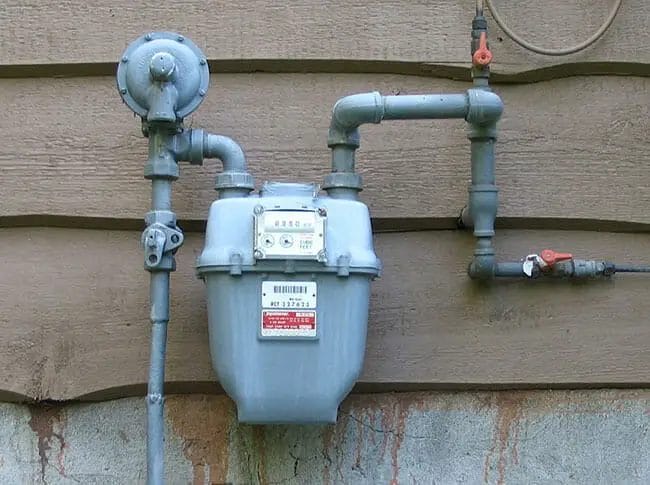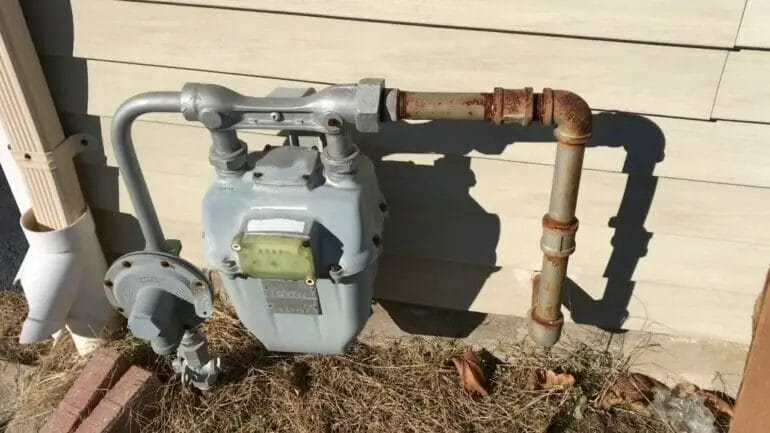Painting a gas meter can be a creative way to add some color to your outdoor space. However, it is important to check with your local gas company or municipal authorities before painting a gas meter, as regulations may vary. In some cases, painting a gas meter might be prohibited due to safety concerns or to ensure the visibility of the meter and its readings. It is always best to seek proper guidance and approval to ensure compliance with the law and maintain the safety of your gas supply.

Factors to Consider Before Painting a Gas Meter: Safety guidelines and legal regulations
Before undertaking the task of painting a gas meter, it is important to consider several factors to ensure safety and compliance with legal regulations. Painting a gas meter requires careful planning and adherence to specific guidelines to avoid any potential hazards. In this section, we will discuss the safety guidelines and legal regulations that should be taken into consideration before painting a gas meter.
Safety Guidelines
When painting a gas meter, the safety of both the painter and the surrounding environment should be the top priority. Here are some important safety guidelines to follow:
- Turn off the gas supply: Before starting the painting process, it is crucial to turn off the gas supply to the meter. This can be done by locating the gas shut-off valve and closing it.
- Protective gear: Wear appropriate protective gear, such as gloves, safety glasses, and a respirator, to protect yourself from any potential fumes or chemicals.
- Proper ventilation: Ensure that the area where the gas meter is located has proper ventilation to prevent the accumulation of any hazardous fumes.
- Avoid open flames: Keep any open flames or sources of ignition away from the gas meter to avoid the risk of fire or explosion.
- No smoking: Do not smoke near the gas meter or in the vicinity to eliminate the risk of igniting flammable gases.
- Use appropriate paint: Select a suitable paint that is specifically formulated for outdoor use and can withstand the elements.
- Proper application: Follow the manufacturer’s instructions for preparing and applying the paint to ensure a safe and long-lasting finish.
- Inspect for leaks: After completing the painting process, carefully inspect the gas meter for any signs of leaks or damage. If any issues are detected, contact the relevant gas utility company for assistance.
Legal Regulations
Painting a gas meter may be subject to specific legal regulations imposed by local authorities or gas utility companies. It is essential to comply with these regulations to avoid any potential legal issues. Here are some common legal regulations to consider:
- Obtain necessary permits: Check with the local authorities if any permits or approvals are required before painting a gas meter. Some jurisdictions may have specific rules and regulations for this task.
- Observe color-coding standards: Gas meters are often color-coded to indicate different types of gas or service. It is important to adhere to the designated colors specified by the gas utility company.
- Follow utility company guidelines: Gas utility companies may have their own guidelines for painting gas meters. These guidelines should be followed to ensure compliance with their requirements.
- Record-keeping: Maintain detailed records of the painting process, including the date, type of paint used, and any other relevant information. This documentation may be required for future reference or inspections.
- Consult professionals: In some cases, it may be necessary to seek professional assistance for painting a gas meter to ensure compliance with all safety and legal requirements.
By considering the safety guidelines and legal regulations outlined above, you can undertake the task of painting a gas meter in a safe and compliant manner. Remember to prioritize safety at all times and consult the relevant authorities or professionals if you have any doubts or questions.

Step-by-Step Guide to Painting a Gas Meter
Painting a gas meter can not only enhance the appearance of your outdoor space but also help protect the meter from the elements. Whether you want to match it with your house’s color scheme or simply give it a fresh new look, painting a gas meter can be a fun and rewarding DIY project. In this section, we will provide a step-by-step guide on how to paint a gas meter, covering the preparation, painting process, and post-painting care.
Preparation
Before you start painting, it is important to ensure that you have all the necessary materials and tools on hand. Here’s what you’ll need:
- Paint suitable for outdoor use
- Primer (if needed)
- Paintbrushes or rollers
- Painter’s tape
- Sandpaper or wire brush
- Cloth or sponge
- Drop cloth or plastic sheeting to protect the surrounding area
Once you have gathered all the supplies, follow these steps to prepare the gas meter for painting:
- Turn off the gas supply and make sure there are no leaks or open flames nearby.
- Clean the surface of the gas meter using a cloth or sponge and mild detergent to remove any dirt, grease, or grime.
- If the gas meter has any rust or peeling paint, use sandpaper or a wire brush to gently remove the loose particles and create a smooth surface.
- Wipe off any dust or debris from the surface with a clean cloth.
- Apply painter’s tape to cover any areas you do not want to paint, such as the meter reading display or the gas valve.
- If necessary, apply a coat of primer to the gas meter. This will help the paint adhere better and provide a more even finish.
Painting Process
Now that the gas meter is prepared, it’s time to start painting. Follow these steps for a smooth and successful painting process:
- Stir the paint thoroughly to ensure a consistent color.
- Using a paintbrush or roller, apply an even coat of paint to the gas meter. Start from the top and work your way down, using long, smooth strokes.
- Allow the first coat to dry completely before applying additional coats, if needed. Follow the manufacturer’s instructions for drying times between coats.
- If you decide to apply multiple coats, sand the surface lightly with fine-grit sandpaper between coats to ensure a smooth finish.
- Continue applying coats until you achieve the desired color and coverage.
- Remove the painter’s tape carefully while the paint is still slightly tacky to prevent peeling.
Post-Painting Care
Once you have finished painting the gas meter, it’s important to take proper care to ensure the longevity of the paint job and the functionality of the meter:
- Avoid placing any objects or decorations directly on the painted surface.
- Regularly inspect the painted gas meter for any signs of damage, such as chipping or peeling paint.
- If you notice any damage, touch up the affected areas with matching paint to prevent further deterioration.
- Keep the surrounding area clean and free from debris that may scratch or damage the paint.
- In case of any maintenance or repair work on the gas meter, follow the instructions provided by the gas company or contact a professional technician.
In summary, painting a gas meter can be a rewarding DIY project that adds a touch of personalization to your outdoor space. By following this step-by-step guide, you can achieve a professional-looking paint job while ensuring the safety and functionality of the gas meter. Remember to always prioritize safety and follow any regulations or guidelines provided by the gas company. Happy painting!

Popular Paint Colors for Gas Meters
Choosing the right color for your gas meter may seem like a small detail, but it can actually make a big impact on the overall appearance of your property. The color you choose can complement your home’s exterior, blend in with the surroundings, or even make a statement. In this section, we will explore some popular paint colors for gas meters to help you make the best choice for your needs.
1. Neutral Colors
Neutral colors such as beige, gray, or taupe are a popular choice for gas meters. These colors blend well with most exterior color schemes and provide a subtle and understated look. Neutral colors are also less likely to fade or show dirt, ensuring that your gas meter looks clean and well-maintained.
2. Earth Tones
If you prefer a more natural look, earth tones like brown, green, or tan can be a great option. These colors mimic the colors found in nature and can help your gas meter blend in with the surrounding landscape. Earth tones are also known for their durability and resistance to fading, making them a practical choice for outdoor applications.
3. Bold Colors
For those who want to make a statement with their gas meter, bold colors can be a fun and eye-catching choice. Bright colors like red, blue, or yellow can add a pop of color to your property and create a focal point. However, it’s important to consider the overall aesthetic of your home and neighborhood before choosing a bold color, as it may not suit every setting.
4. Metallic Finishes
If you’re looking for a more modern and sophisticated look, metallic finishes can be a stylish choice for your gas meter. Silver, bronze, or copper finishes can add a touch of elegance and create a sleek and polished appearance. Metallic finishes are also durable and resistant to weathering, ensuring that your gas meter retains its shine for years to come.
5. Custom Colors
If none of the popular paint colors appeal to you, you can also opt for a custom color for your gas meter. Many companies offer custom color matching services, allowing you to choose a color that perfectly suits your preferences and complements your home’s exterior. Keep in mind that custom colors may require additional time and cost, but they can give you the exact look you desire.
In summary, choosing the right color for your gas meter is an important decision that can enhance the overall aesthetic of your property. Whether you prefer neutral tones for a subtle look, earth tones for a natural blend, bold colors for a statement, metallic finishes for a modern touch, or custom colors for a personalized touch, there are plenty of options available. Consider your home’s exterior, surroundings, and personal preferences to select a paint color that will make your gas meter a functional and visually appealing part of your property.
Maintenance Tips for Painted Gas Meters: Extending the lifespan of your painted gas meter
Painted gas meters need regular maintenance to ensure their longevity and efficiency. By following a few simple tips, you can extend the lifespan of your painted gas meter and avoid costly repairs or replacements. In this section, we will discuss some essential maintenance practices for painted gas meters.
1. Clean the surface regularly
One of the easiest ways to maintain a painted gas meter is by cleaning its surface regularly. Use a mild soap solution and a soft cloth or sponge to gently remove dirt, dust, and grime from the meter’s exterior. Avoid using harsh chemicals or abrasive materials that can damage the paint or surface of the meter.
2. Inspect for any signs of damage
Regularly inspecting your painted gas meter for any signs of damage is crucial to prevent further issues. Look for chips, cracks, or peeling paint on the surface. If you notice any damage, it is essential to address it promptly to prevent corrosion or other problems. In some cases, repainting may be necessary to protect the meter from the elements.
3. Protect the meter from extreme weather conditions
Extreme weather conditions, such as heavy rain, snow, or direct sunlight, can damage the paint on your gas meter. Take preventive measures to protect the meter from these elements. Consider using a protective cover or shelter to shield the meter from direct exposure. Additionally, ensure proper insulation to prevent moisture buildup, as it can lead to paint damage and corrosion.
4. Be cautious when landscaping around the meter
When landscaping your property, it is crucial to be cautious around the painted gas meter. Avoid using lawnmowers or other heavy equipment near the meter, as they can cause accidental damage to the surface. Trim any vegetation or bushes around the meter regularly to prevent them from rubbing against the paint and causing scratches or abrasions.
5. Schedule regular maintenance checks
Regular maintenance checks by a qualified technician can help identify and address any issues with your painted gas meter. Schedule annual or biannual inspections to ensure that the meter is functioning correctly and that the paint is in good condition. These inspections can help catch any potential problems early on, saving you time and money in the long run.
6. Apply touch-up paint when needed
If you notice any minor chips or scratches on the surface of your painted gas meter, it is advisable to apply touch-up paint promptly. Using the manufacturer-recommended paint or consulting a professional can ensure that the touch-up matches the existing paint and provides adequate protection against the elements.
7. Maintain proper clearance around the meter
It is essential to maintain proper clearance around the painted gas meter to ensure proper airflow and prevent any obstructions. Clear away any debris, vegetation, or other objects that may impede the meter’s functionality. This will help maintain optimal performance and prevent potential damage.
Summary
By following these maintenance tips for painted gas meters, you can extend their lifespan and ensure their efficient performance. Regular cleaning, inspection for damage, protection from extreme weather conditions, cautious landscaping practices, regular maintenance checks, touch-up painting, and maintaining proper clearance are all essential steps to maintain the longevity and functionality of your painted gas meter. Taking these measures will not only save you money in the long run but also contribute to the smooth operation of your gas system.
FAQs
Is it legal to paint a gas meter?
The legality of painting a gas meter can vary depending on local regulations and the gas utility company’s policies. In some cases, painting a gas meter may be prohibited to ensure visibility and safety. It is best to contact your local gas utility company to inquire about their specific guidelines regarding painting gas meters.
Conclusion
In summary, painting a gas meter can be a creative way to enhance its appearance and blend it with the surroundings. It is important to note, however, that regulations regarding the painting of gas meters may vary based on local laws and utility company policies. Before proceeding, it is advisable to check with your gas utility company to ensure that painting the gas meter is allowed and to follow any specific guidelines they may have. By doing so, you can add a personal touch to your gas meter while ensuring compliance with legal requirements and maintaining safety.
